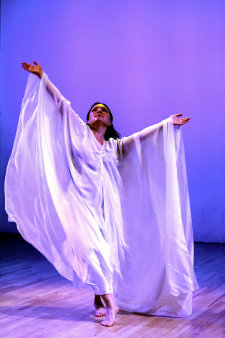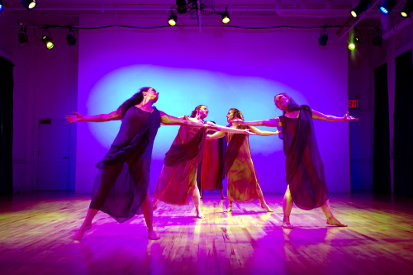
Rina Kopalla
|
Awakening
Rhythms. "Awakening Rhythms. A dancer's 20-year
journey in NYC." On November 3 and 4, the Swiss native dancer Francesca Todesco joined forces with Dances by Isadora, Sokolow Dance Ensemble and the Thoughts in Motion Dance Company at University Settlement to present a variety of recreated works by American modern dance pioneers such as Isadora Duncan and Anna Sokolow. Musical interludes in between the performances made for a varied evening of American modern dance and classical music.
The Saturday evening program started with the solo "Poem" by Anna Sokolow and danced by Todesco herself. Using gestures of gratitude, she seemed grateful yet still yearning for something. It was the first piece in the lineup, so I wondered if this was how she felt in her early years in New York and if there was any correlation. After a musical interlude (which I initially thought was part of the piece), Todesco continued, dancing "Harp" by Isadora Duncan, a piece emblematic of the dance genre New Dance. Situated in the beginning of the 20th century, New Dance places itself against the hierarchy of classical ballet and creates on the choreographer's own body. The dancers are barefoot and grounded. The individual body in the room becomes important: we see the concept of room being used a movement concept. Since the reconstructed dances were taken mostly from around that time, there were a lot of solos present in the program, all danced by Francesca Todesco. I watched the concert with a fellow dancer and we were both impressed with Todesco's endurance throughout the pieces she danced in, and especially with her ability to sustain expressiveness. Not only she, but most of the dancers displayed a free expressiveness. The costumes, Grecian in style, gave the performance another movable body. What I mean is, whenever the dancers would spin, their dresses would give the turn a different dimension by moving with and after it. The individual life of the dress, very visible and beautiful in the turns, seemed to absorb the dancer's body and form another sculpture in the room. The performances (except "Sleeping Bouquet") were accompanied by live music by the wonderful pianists Nathaniel LaNASA and Isidora Vladic.
The evening showcased twelve different pieces. From lightness ("Harp") to heaviness ("Mother"), melancholic ("Poem") to powerful ("Polonaise Militaire"), empowering ("Wave") to vulnerable ("Sleeping Bouquet") - all was present. As a little dance historian myself, reconstructions (even though they are reconstructions) excite me. The night was rich in dance history; you don't often get to see all these dances all in one place. "Sleeping Bouquet" was my favorite of the night, because both the dancers, Francesca Todesco and Daniel Fetecua Soto, worked well together and were very expressive. A duet in pajamas, it started on the floor with him sleeping; she was dancing around and over him. She played beautifully with his presence and absence, her touches not physically reaching yet touching him. It seemed like she was tapping around in his dreams. [Kopalla] |
| home |
columnists | reviews |
cue-to-cue | welcome |
| museums | recordings |
coupons | publications |
classified |

